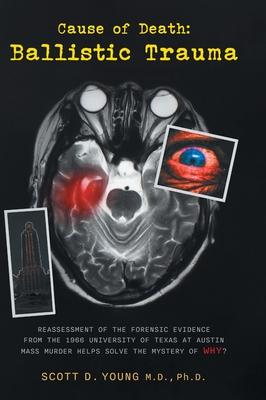
Book
Cause of Death: Ballistic Trauma: Reassessment of the Forensic Evidence from the 1966 University of Texas at Austin Mass Murder Helps
(Write a Review)
$55.99
As a former Marine and excellent marksman, Whitman had extensive experience with firearms but had no history of criminal activity or mental illness. The shooting spree, therefore, left many scrambling for answers. A clue emerged from Whitman's suicide note. In it, he said that he knew something was wrong with himself and requested that an autopsy be performed after his death. A malignant tumour was found deep in his brain, which ignited a fierce debate amongst medical experts about its role in Whitman's final violent actions.
Cause of Death: Ballistic Trauma seeks to settle this debate by explaining the mechanisms of how the tumour was instrumental in influencing Whitman's behaviour. The book explores how obstructive hydrocephalus and temporal lobe seizures may have led to the destructive events on that fateful day. Written by retired medical oncologist, Dr. Scott Young, who spent more than twenty years caring for patients with brain tumours, this book explores the neuroscience behind this mass murder. Drawing upon problem-solving techniques used in forensics, and supported with extensive references and images, Young puts forth an argument that Charles Whitman was probably not legally responsible for his actions. This is his first book.
As a former Marine and excellent marksman, Whitman had extensive experience with firearms but had no history of criminal activity or mental illness. The shooting spree, therefore, left many scrambling for answers. A clue emerged from Whitman's suicide note. In it, he said that he knew something was wrong with himself and requested that an autopsy be performed after his death. A malignant tumour was found deep in his brain, which ignited a fierce debate amongst medical experts about its role in Whitman's final violent actions.
Cause of Death: Ballistic Trauma seeks to settle this debate by explaining the mechanisms of how the tumour was instrumental in influencing Whitman's behaviour. The book explores how obstructive hydrocephalus and temporal lobe seizures may have led to the destructive events on that fateful day. Written by retired medical oncologist, Dr. Scott Young, who spent more than twenty years caring for patients with brain tumours, this book explores the neuroscience behind this mass murder. Drawing upon problem-solving techniques used in forensics, and supported with extensive references and images, Young puts forth an argument that Charles Whitman was probably not legally responsible for his actions. This is his first book.
Hardcover
$55.99